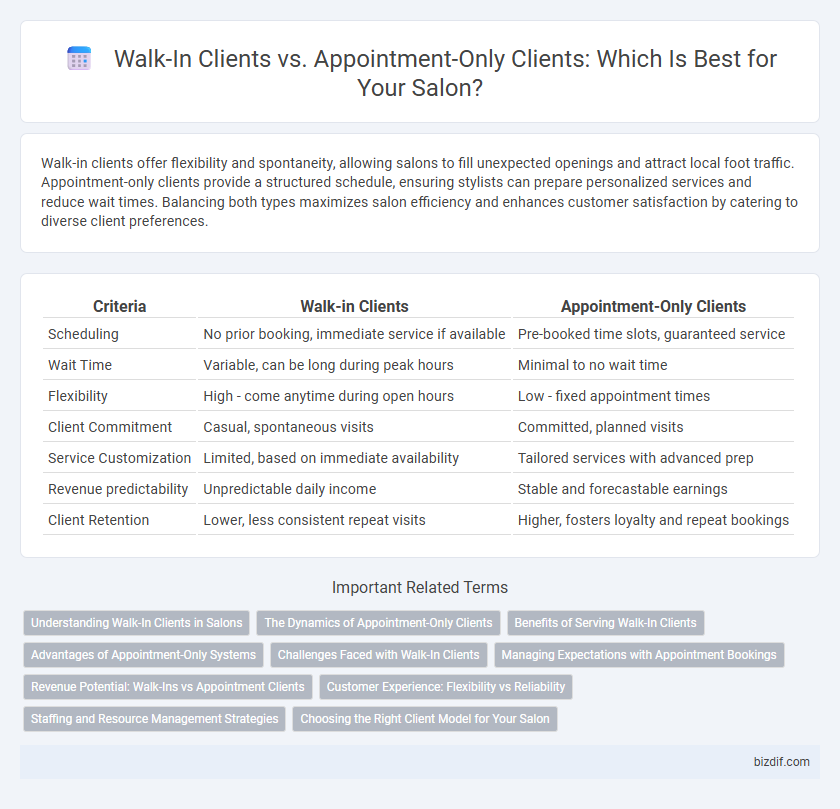Walk-in clients offer flexibility and spontaneity, allowing salons to fill unexpected openings and attract local foot traffic. Appointment-only clients provide a structured schedule, ensuring stylists can prepare personalized services and reduce wait times. Balancing both types maximizes salon efficiency and enhances customer satisfaction by catering to diverse client preferences.
Table of Comparison
| Criteria | Walk-in Clients | Appointment-Only Clients |
|---|---|---|
| Scheduling | No prior booking, immediate service if available | Pre-booked time slots, guaranteed service |
| Wait Time | Variable, can be long during peak hours | Minimal to no wait time |
| Flexibility | High - come anytime during open hours | Low - fixed appointment times |
| Client Commitment | Casual, spontaneous visits | Committed, planned visits |
| Service Customization | Limited, based on immediate availability | Tailored services with advanced prep |
| Revenue predictability | Unpredictable daily income | Stable and forecastable earnings |
| Client Retention | Lower, less consistent repeat visits | Higher, fosters loyalty and repeat bookings |
Understanding Walk-In Clients in Salons
Walk-in clients in salons play a crucial role in driving spontaneous business and filling schedule gaps, often bringing in immediate revenue without prior booking commitments. These clients prefer flexibility and convenience, relying on salon availability rather than planned appointments, which requires salons to maintain readiness for unexpected service requests. Understanding walk-in client behavior helps salons optimize staffing, inventory, and marketing strategies to balance both walk-in and appointment-only customer flows efficiently.
The Dynamics of Appointment-Only Clients
Appointment-only clients contribute to a more predictable and efficient salon schedule, reducing wait times and enabling stylists to prepare personalized services in advance. This model enhances customer satisfaction by ensuring dedicated time slots and tailored attention, increasing the likelihood of repeat visits and client loyalty. Salons implementing appointment-only policies often experience improved cash flow stability and better resource management compared to walk-in client dynamics.
Benefits of Serving Walk-In Clients
Serving walk-in clients increases salon revenue by maximizing chair utilization during unexpected openings and slow periods. It enhances customer satisfaction through convenience and immediate service, attracting a broader clientele seeking spontaneous beauty treatments. Walk-in availability also fosters stronger community engagement and boosts brand visibility by accommodating diverse schedules without the constraints of pre-booked appointments.
Advantages of Appointment-Only Systems
Appointment-only systems in salons enhance scheduling efficiency by reducing wait times and minimizing client overlap, leading to a more organized workflow. This structure enables stylists to allocate focused time for personalized services, improving customer satisfaction and service quality. Additionally, appointment-based models help salons manage inventory and staffing more accurately, optimizing operational costs.
Challenges Faced with Walk-In Clients
Walk-in clients create scheduling unpredictability for salons, often leading to overbooking and extended wait times that disrupt service flow. Staff may face increased pressure to accommodate sudden surges, resulting in decreased efficiency and potential declines in service quality. This variability complicates resource allocation and inventory management, impacting overall customer satisfaction and business profitability.
Managing Expectations with Appointment Bookings
Managing expectations with appointment bookings involves clearly communicating service duration, availability, and cancellation policies to clients. Walk-in clients often face uncertainty regarding wait times, while appointment-only clients benefit from a structured schedule that maximizes efficiency and customer satisfaction. Salons utilizing online booking systems can streamline appointments, reduce no-shows, and provide real-time updates to enhance the overall client experience.
Revenue Potential: Walk-Ins vs Appointment Clients
Walk-in clients provide immediate revenue opportunities with spontaneous bookings that often fill last-minute gaps in the schedule, boosting daily cash flow. Appointment-only clients typically generate higher average revenue through planned, premium services and add-ons, allowing for optimized staffing and inventory management. Balancing both client types maximizes revenue potential by combining consistent, high-value appointments with flexible, walk-in-driven sales surges.
Customer Experience: Flexibility vs Reliability
Walk-in clients enjoy the flexibility of spontaneous visits, enhancing convenience and catering to immediate beauty needs, which can improve overall customer satisfaction. Appointment-only clients benefit from reliability and personalized attention, ensuring dedicated time and tailored services that foster trust and loyalty. Balancing these approaches allows salons to optimize customer experience by accommodating diverse preferences and operational efficiency.
Staffing and Resource Management Strategies
Staffing and resource management in salons require balancing walk-in clients with appointment-only clients to optimize service efficiency. Allocating flexible staff schedules and maintaining on-demand resources ensure seamless handling of unpredictable walk-in volumes while honoring pre-booked appointments. Leveraging salon management software that tracks client flow and staff availability enhances operational productivity and maximizes client satisfaction.
Choosing the Right Client Model for Your Salon
Selecting the appropriate client model for your salon significantly impacts operational efficiency and customer satisfaction. Walk-in clients provide flexibility and increased daily foot traffic, while appointment-only clients enable better scheduling, personalized service, and revenue predictability. Evaluating your salon's capacity, target market, and service offerings helps determine whether a walk-in, appointment-only, or hybrid model maximizes client retention and overall profitability.
Walk-in clients vs Appointment-only clients Infographic

 bizdif.com
bizdif.com